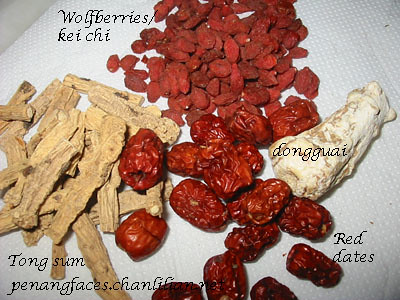I found that it is very hard to find photos of Chinese herbs with their common names in English. For a person like me who doesn’t read Mandarin, it is a disadvantage.
So, I am archieving whatever Chinese herbs I am using on this blog. I had blogged about a few types of Chinese herbs here.
A few months back, I also shared the recipe of duck drumstick mee suah (wheat noodle) which uses some of these Chinese herbs.
The above are four herbs comprising:
1) Dongguai – Most of the time, people bought the dongguai slices. Shown here is the whole root. It is better getting the whole root because when it has been sliced, the ‘smell’ dissipated. I just need to take the chopper to break it into huge pieces. Dongguai has a very strong smell, so use sparingly.
2) Tong sum – There are good quality tongsum which comes in bigger roots, intact too. The one shown above is a cheaper variety.
3) The small tiny, red seeds is wolfberries or sometimes called boxthorn berries. The Chinese name is kei chi. It adds a sweetish taste to soups and are often used in Chinese soups.
4) Lastly, the red dates. Nowadays, red dates are seeded before being sold. If it is not, one has to manually remove the seeds. I was told that it is not good to brew soups with the seeds because it may cause the eyes to blur (hmmm?). Can’t verify that, though.
I am braising lamb shoulder with the above herbs. Recipe later.

